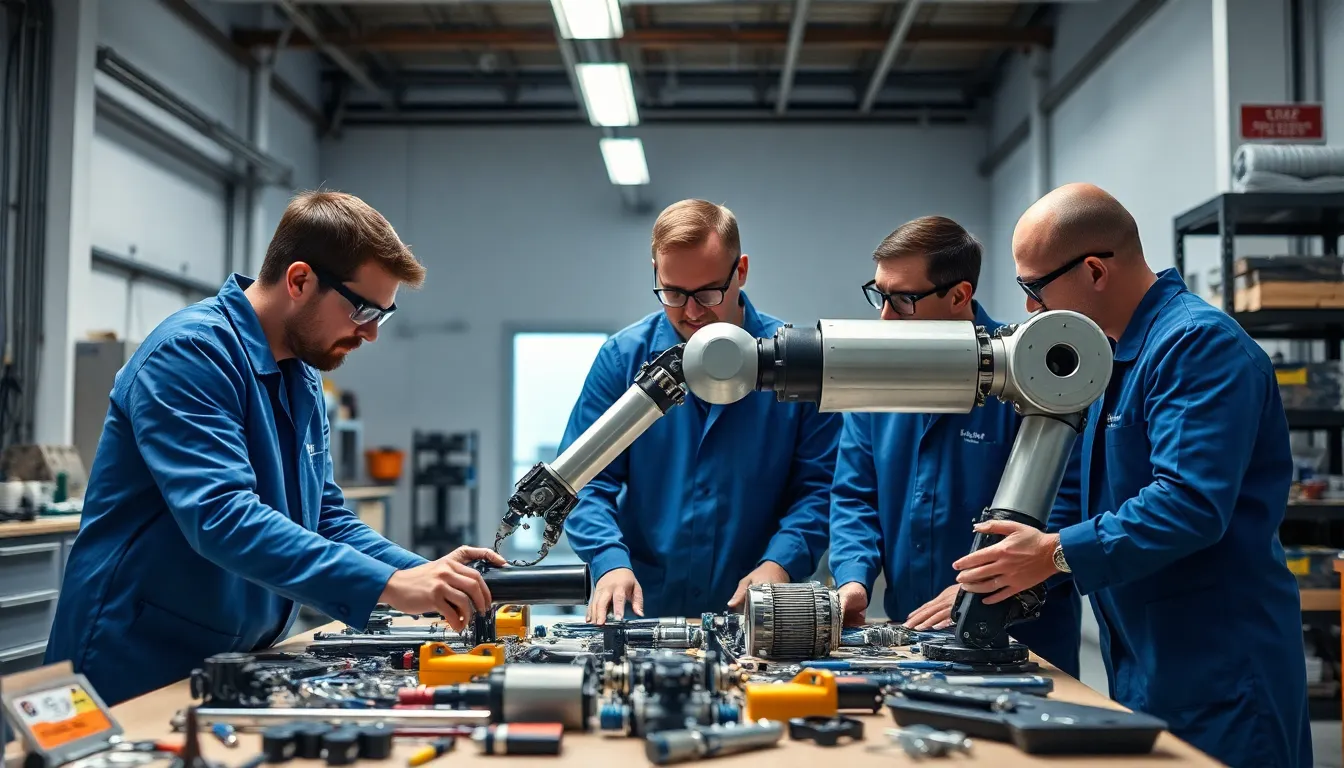Table of Contents
ToggleIn a world where robots are becoming our new best friends, the question arises: is robotics just a fancy branch of mechanical engineering? Picture this: a robot that can brew your coffee, vacuum your floors, and maybe even tell a joke or two. Sounds like a dream, right? But behind that shiny exterior lies the intricate world of engineering that makes it all possible.
Robotics is a mash-up of creativity and technical know-how, where mechanical engineering plays a vital role. It’s not just about gears and motors; it’s about designing intelligent machines that can think, learn, and maybe even help you with your taxes someday. So, let’s dive into this fascinating field and uncover how robotics and mechanical engineering dance together in perfect harmony, creating the future one robot at a time.
Overview of Robotics and Mechanical Engineering
Robotics represents a multifaceted discipline intertwining aspects of mechanical engineering. It encompasses the design, construction, and operation of robots. Mechanical engineering offers foundational principles, such as mechanics, materials science, and dynamics, crucial for creating robotic systems.
Mechanical engineers design the structural components of robots. They apply knowledge about gears, motors, and actuators. These elements provide movement and functionality for various applications, from manufacturing to healthcare. Advanced robotics also incorporates sensors for real-time feedback, enabling adaptability in different environments.
Electrical and computer engineering plays a significant role in robotics. Control systems integrate with mechanical components, programming robots to perform specific tasks. They enhance precision and efficiency through algorithms. Intuitive user interfaces provide operators with tools to interact seamlessly with robotic systems.
Mechanical engineering and robotics pave the way for innovation in automation. Industries benefit from increased productivity and safety. Autonomous vehicles, robotic surgery, and smart manufacturing exemplify the impact of combining these fields.
Collaboration across disciplines amplifies the potential of robotics. Integration of artificial intelligence introduces advanced capabilities, allowing machines to learn and make decisions. Human-robot interaction becomes crucial, emphasizing ergonomics and usability in design.
Continuous advancements mark the evolution of robotics within mechanical engineering. Emerging technologies like soft robotics present new challenges and opportunities. These developments highlight the need for ongoing research and interdisciplinary knowledge, further solidifying the connection between robotics and mechanical engineering.
The Relationship Between Robotics and Mechanical Engineering

Robotics encompasses a range of disciplines, closely linking it to mechanical engineering. This connection forms the basis of both design and functionality in robotic systems.
Shared Principles
Mechanical engineering principles such as statics, dynamics, and thermodynamics serve as the foundation for robotics. Engineers utilize these principles to ensure robots can withstand operational stresses while maintaining efficiency. Mechanics plays a crucial role in analyzing movements and forces within robotic structures. Additionally, materials science guides engineers in choosing suitable materials for durability and performance. Dissecting these shared principles reveals their importance in creating innovative robotic solutions, ensuring robust designs that perform reliably across various environments.
Areas of Overlap
Robotics and mechanical engineering overlap in various fields such as manufacturing, healthcare, and automation. In manufacturing, robots streamline production processes, improving efficiency and precision. In healthcare, robotic systems assist with surgeries and rehabilitation, enhancing patient outcomes. Moreover, automation combines mechanical systems with control algorithms to simplify complex tasks. These areas showcase how mechanical engineering contributes to the evolution of robotics, driving progress in areas that require integration of physical systems with intelligent processing capabilities. The intersection of these disciplines fosters advancements that redefine industry standards and capabilities.
Applications of Robotics in Mechanical Engineering
Robotics plays a crucial role in mechanical engineering, showcasing innovative applications across various industries. These applications enhance efficiency, precision, and productivity.
Manufacturing Automation
Manufacturing automation stands as a primary application of robotics in mechanical engineering. Robots streamline repetitive tasks such as assembly and material handling, significantly reducing production times. Collaborative robots, or cobots, work alongside humans to improve safety and efficiency on the production floor. Industries utilize robotic arms for welding, painting, and packaging, leading to decreased human error and increased output. According to recent studies, implementing robotics in manufacturing can boost productivity by up to 30 percent, demonstrating substantial economic benefits.
Design and Prototyping
Design and prototyping leverage robotics to create advanced engineering solutions. Engineers use robotic systems to model complex structures and test prototypes in virtual environments. This process accelerates product development cycles, allowing for rapid iterations during the design phase. Robotics tools, like 3D printers and CNC machines, facilitate precision manufacturing, making it easier to create intricate designs. Furthermore, simulation software helps engineers evaluate robotic movements and efficiencies before physical implementation, ensuring better performance and resource allocation in final products.
The Future of Robotics in Mechanical Engineering
Robotics heavily influences the future of mechanical engineering and innovations emerge frequently. Advancements in technology continue to reshape the landscape, driving further integration between robotics and engineering disciplines.
Emerging Technologies
New technologies like artificial intelligence and machine learning enhance robotic capabilities and performance. Soft robotics promises safer interactions in delicate environments such as healthcare, allowing for robots to handle tasks with precision. Additionally, 3D printing offers opportunities for rapid prototyping and customizable designs in robotic components. Significant enhancements in sensors lead to better data collection, advancing autonomous systems. Collaborative robots, or cobots, facilitate safer human-robot teamwork by adapting to various tasks. Continued research in these areas will expand applications across multiple industries, driving innovation and efficiency.
Career Opportunities
Robotics opens various career paths within mechanical engineering. Opportunities exist in design roles where engineers create and improve robotic systems. Professionals specializing in automation can implement and maintain robotic solutions in manufacturing environments. Research positions focus on developing cutting-edge technologies for intelligent machines. Project management roles oversee robotics projects, ensuring they meet deadlines and budgets. Additionally, interdisciplinary roles combine expertise in robotics, computer science, and electrical engineering to push the boundaries of innovation. The demand for skilled professionals in robotics continues to grow, making it an attractive field for aspiring engineers.
The intersection of robotics and mechanical engineering is a dynamic and evolving landscape. As technology advances the integration of these fields continues to redefine industry standards and enhance efficiency. The collaboration not only fosters innovation but also opens up new career opportunities for skilled professionals.
With the rise of artificial intelligence and emerging technologies like soft robotics the future looks promising. This synergy will likely lead to even more sophisticated robotic systems capable of transforming various sectors. Embracing this relationship is essential for those looking to thrive in the ever-changing world of engineering and automation.






